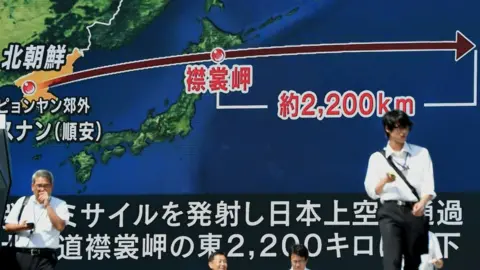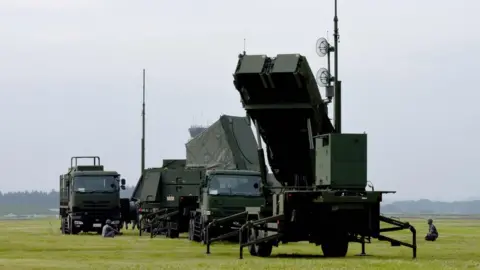North Korea missile: How long has Japan got to defend itself?
 AFP
AFPHow long do people in Japan have to react to a North Korean missile launch? Virtually no time at all.
The latest North Korean missile was launched at 06:57 Japan time, according to Japan's defence ministry.
Citizens received a text message alert from the government at 07:00, warning that a missile had been launched and advising them to seek shelter indoors or underground.
Between 07:04 and 07:06, the missile flew over the northern island of Hokkaido. It eventually landed in the Pacific, to the east of Japan, at 07:16.
In other words, if the missile had been launched at a Japanese target, there could have been as little as four minutes between receiving the alert and impact - very little time to get to safety. And that's assuming people see the messages as soon as they're sent.
That's slightly longer than last time - on 29 August, there were just three minutes between the alert being sent at 06:02 and the missile arriving over Hokkaido at 06:05.
Allow X content?
Missile defence
So defensive measures become extremely important.
What does Japan have at the moment, and what else could it get?
The current missile defence system comes in two stages.
There is the Aegis system, which is deployed on Japanese, US and South Korean naval craft in the region. It is designed to intercept missiles in early or mid-flight.
Then there are a number of short-range Patriot anti-missile batteries (PAC-3) deployed in Japan. They are designed to shoot down missiles as they descend towards their target.
It's not a bad combination, but for the Aegis system your ships have to be in the right place at the right time for intercept to be possible.
And while the Patriot system can provide effective defence for specific locations, it is less effective if it needs to defend a wide area.
 AFP
AFPThere are alternatives, but they are expensive and would take time to install.
Japan could invest in a land-based Aegis system which would provide extra security. Or it could consider an extra layer of defence such as the Terminal High-Altitude Area Defence (THAAD) system, which has been deployed in Guam and supplied by the US to South Korea.
The THAAD system is not really battle-tested, however.
The trouble is that none of these defence systems would provide guaranteed protection against a barrage of missiles, fired unexpectedly.
That's why there has been debate in the Japanese defence establishment about acquiring advanced systems that would allow Japan to destroy North Korean missiles either on the point of launch or even pre-emptively.
It is not clear, though, whether this would be permissible under Japan's pacifist constitution.



